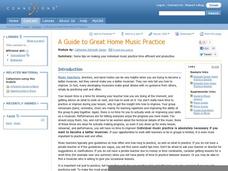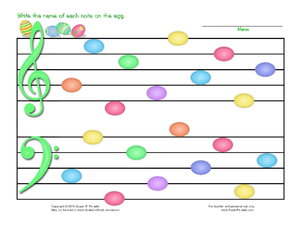Fun Music Company
Transposition
Up a perfect fifth, down an octave. Transposing a piece to suit the range of singers, and instrumentalists, is a key skill musicians must perfect. This worksheet explains how to transpose and gives learners a change to practice.
Fun Music Company
Working Out the Key
"Gimme an E minor!" Or any key for that matter. But how do you figure out the key of a piece of music? Here's a worksheet that shows young musicians three easy steps to help them identify the key of a piece of music.
Fun Music Company
Classification of Intervals
Major 2nd, Perfect 4th, Minor 3rd. The number and classification of intervals are the focus of a one-page worksheet that asks musicians to write the intervals above given notes and to indicate the classification of others.
Fun Music Company
Writing Major Scales
Designed as an assessment of understanding, this one-page worksheet asks musicians to demonstrate their understanding of scales by drawing C, G, and F Major scales on the provided staffs.
Curated OER
Treble Clef Quiz Part I: The Basics
This three-part quiz tests learners knowledge of the treble clef by asking them to name the parts of the treble clef, to write the letter names under the notes represented, and to write the note names on the correct line or space.
Curated OER
Outline: Notes of the Treble Clef Staff
Score one for test prep. Young musicians are encouraged to create their own mnemonic devices to prepare themselves for a test on the treble clef staff. Using the provided worksheet, individuals record, in order, the names of the lines...
Curated OER
Bass Clef Note Names Test
Asses your musicians' knowledge of clef note names with a two-page test that asks them to identify the names represented by the nomenclature and then to place a whole note on the line or space that is appropriate for the letter name.
VH1
Lesson 4: Behind the Movie Chicago
The elements of music and journalistic integrity in one lesson; What could be better? The class discusses journalistic approaches to better understand responsible reporting versus sensationalism. They watch the Act One from the film...
Curated OER
A Guide to Great Home Music Practice
To be the very best musician one needs to be wiling to practice at home. Here is a handy guide to give your young musicians a leading edge on home music practice. It includes a warm up, cool down, suggestions for setting goals and for...
Curated OER
Missing the Major Scales 2
Any musician can tell you, you have to know your scales, key signatures, and notes when reading sheet music. Kids are quizzed on major scales and the notes found with in each scale. They fill in the missing notes and identify each scale.
Curated OER
Simple Sharps
If you want to play music, you need to learn how to read sharps and flats. Young musicians practice reading and playing these simple sharps. Each sharp is given a word that connects it to the note it is related to. For example: Charles...
Curated OER
Kindergarten Music Lesson
Singing, clapping, moving up and down with the melody, it all sounds like a great music lesson. Kinder-musicians sing three different songs to practice memory, speaking, and movement skills. They'll move to the melody, build memory with...
Curated OER
Music Review Test
Wow this is a really thorough music quiz. There are a total of seven tasks for the class to complete. They must, write the C major scale, identify notes on the staff, write four major keys based on the information provided, identify...
Curated OER
Triads, Intervals, Keys, Note Values
Older or more advance musicians can test how well they can identify specific triads, intervals, keys, and note values with this quiz. Each staff focuses on one concept, they write the name of the triad, interval, or key.
Curated OER
Fearless Flats
This handout gives budding musicians an opportunity to practice placing and identifying notes and flats. A mnemonic is used to help them remember the names of each note as it appears on the staff.
Curated OER
Notes in the Fast Lane: Quiz
Here are four quizzes that cover note identification on the staff. Each page contains four sections, where the timed learners must identify and fill in the name of each note. These are titled as level 5, 6, 7, and 8, which implies that...
Curated OER
Putting Pitch In Its Place
Students focus on reading musical notations. They see, hear, practice and write notations in the lessons to become more independent readers of music. They complete a Rubric for Pitch Worksheet.
Curated OER
Math, Fractions, and Music
Students discover the relationship between musical rhythms and fractions. They add musical notes together to produce fractions and create addition and subtraction problems with musical notes. Students complete worksheets and create their...
Curated OER
Comparing Values: Comparisons Between Musical Notation and Money
Students identify ways in which the principles and subject matter of other disciplines taught in school, specifically math, are interrelated with those of music.
abcteach
Music Note Cards
Help young musicians stay on beat with this series of classroom displays. Showing the name and symbol for different musical notes, these tools are a handy resource for any elementary or middle school music teacher.
Curated OER
Basketball Notes
Students add the value of various musical notes to win a chance to shoot a basketball. They compete in teams and consider the values of quarter, half and whole notes to complete related math problems.
Curated OER
Using Harmonic Vision’s Music Ace Software to Reinforce Basic Music Skills
If you have access to Harmonic Vision’s Music Ace Software, then this activity could work for you. Kindergarteners use the video music software to place, identify, and read musical notes. They listen in and identify both high and...
Curated OER
Easter Egg Musical Notes
Pastel Easter Eggs are all over this staff, and it's up to your young musicians to analyze each one. They write the name of the note in each egg to practice identifying notes while reading music.
Curated OER
Timed Note Identification
Before you can play from sheet music, you need to be able to read it. This timed quiz requires the class to identify as many of the 90 notes as they can. Notes are on a staff in both treble and bass clef.

























